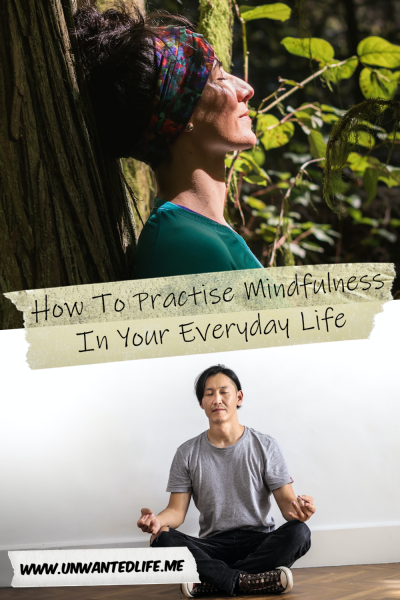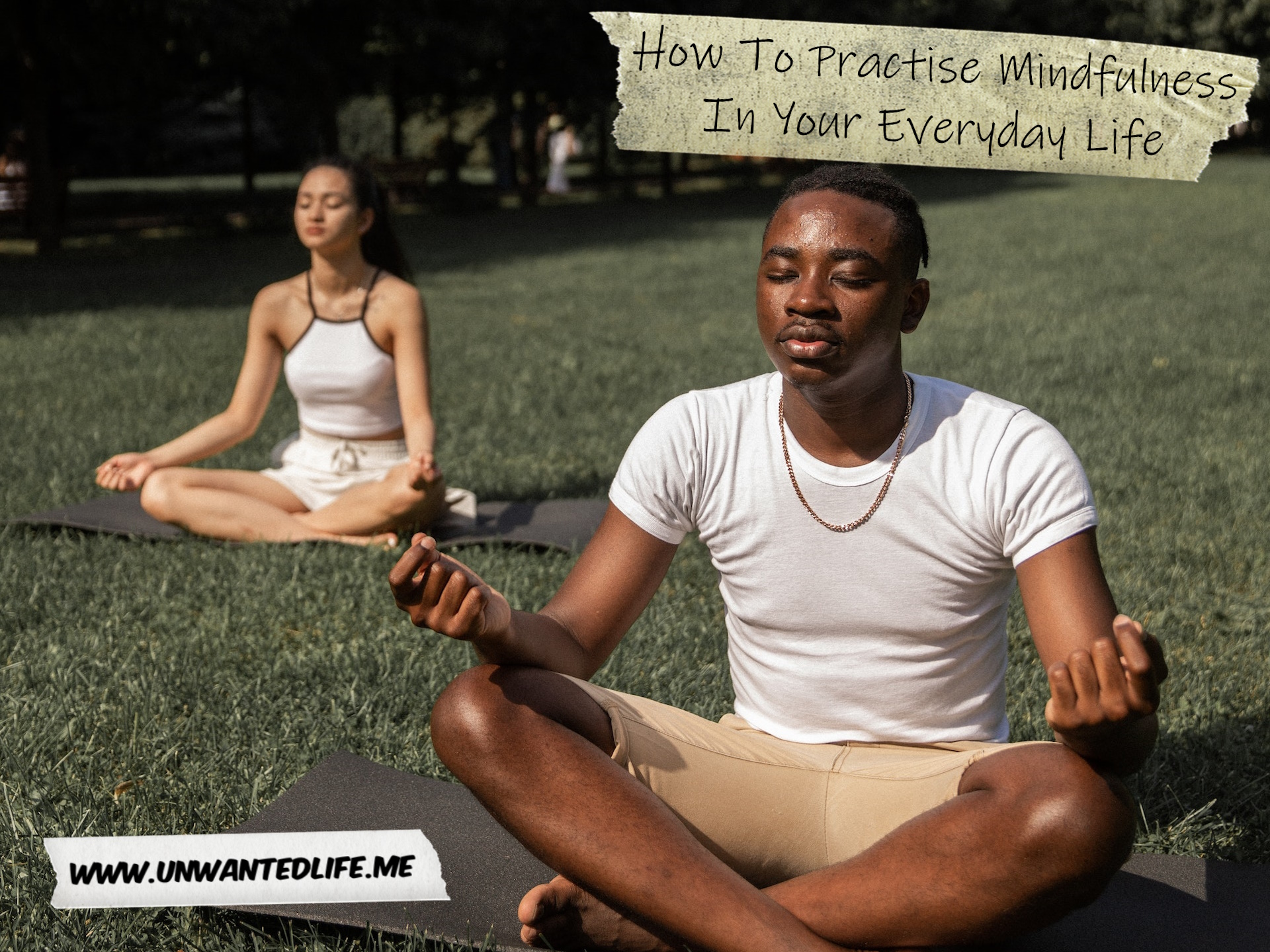This article is to work in conjunction with an article I’ll be releasing next week, making it a two-part series of sorts. But they will also both function as standalone articles. This article, as the title suggests, is about how you can practise mindfulness in your everyday life.
What Is Mindfulness?
According to The Greater Good Science Center at the University of California, Berkeley, mindfulness is where you maintain a moment-by-moment awareness of your body sensations, thoughts, feelings, and surroundings. Or more simply put, it’s the ability to be fully present in the moment (Mindful).
Benefits Of Practising Mindfulness In Your Everyday Life
Practising mindfulness in your everyday life can bring about numerous benefits, such as reducing stress, increasing self-awareness, and enhancing overall well-being. Support for this comes from the National Institutes of Health, which states that studies have shown that mindfulness-based treatments can cause a reduction in anxiety and depression, as well as lowering blood pressure and improving sleep. They even suggest it may help people cope with pain.
This is further supported by Passmore and Marianetti (2022) who state that within the field of coaching, the coach and the coachee can both benefit from the use of mindfulness. They claim that it’ll help reduce stress and lead to happier life experiences.
How To Practise Mindfulness In Your Everyday Life
Dedicated time
Set aside a specific time slot each day for practising mindfulness in your everyday life. It could be as short as five minutes or as long as 30 minutes, depending on your schedule and preference. But what’s most important is consistency. Consistency helps a routine become a habit.
Find a quiet space
If possible, try to find a quiet and comfortable place where you can sit without distractions to engage with mindfulness. It could be a corner in your home, a park, or any serene location that allows you to focus. At a push, maybe the bathroom at work.
Focus on your breath
There are several breathing exercises you can use to tap into mindfulness, but you can also keep it simple. Take a few deep breaths and bring your attention to the present moment. Notice the sensation of your breaths as you inhale and exhale. Let go of any thoughts or worries, and simply observe your breath.
Observe your thoughts and emotions
Allow your thoughts and emotions to arise without judgment. Notice them as they come and go, acknowledging their presence without getting caught up in them. Cultivate a sense of curiosity and openness.
This can also be a useful way to identify areas you might want to work on. If you find your mind being pulled to certain thoughts and feelings, then it could be a sign that there is something unresolved you may need to deal with.
Engage your senses
Pay attention to your surroundings and engage your senses fully. Notice the sounds, sights, smells, tastes, and physical sensations around you. Immerse yourself in the present moment and experience it fully.
A warning based on my personal experience. If you have anxiety that can be affected by your physical sensations, then it might be best to avoid this suggestion. When I tried it, it triggered my anxiety and my psychosis because both are grounded in how my body feels.
Practice mindful eating
This is something I keep trying to engage in because I have a tendency to eat fast, as I don’t really care about food. Unfortunately, that isn’t good for your wellbeing. Thus, during meals, slow down and savour each bite. Pay attention to the flavours, textures, and smells of the food. Chew slowly and mindfully, fully experiencing each mouthful.
By practising mindful eating, you can develop a healthier relationship with food, enhance your enjoyment of meals, and cultivate a greater awareness of your body’s needs and signals. It’s a simple way to bring mindfulness into your daily life and promote overall wellbeing.

Incorporate mindfulness into existing activities
Bring mindfulness into your daily routines, such as brushing your teeth, taking a shower, or doing household chores. Be fully present in each activity, focusing on the sensations and actions involved.
Use reminders
Place reminders in your environment to prompt mindfulness throughout the day. It could be a sticky note on your desk or a notification on your phone. Whenever you notice these reminders, take a moment to pause, breathe, and recenter yourself. I recently had this conversation with a client, whereby we set up reminders for their mindfulness, which included setting alarms and using sticky notes.
Practice gratitude
Cultivate a sense of gratitude by consciously acknowledging and appreciating the positive aspects of your life. Each day, take a few moments to reflect on the things you are grateful for, whether big or small. This is a perfect task for a journal. By writing down the things you’re grateful for, you can review what you’ve written when you’re having a bad day as a pick-me-up.
Practice self-kindness
I can’t stress this enough. Be kind and compassionate toward yourself as you engage in mindfulness. Be kind and compassionate towards yourself when you’re not engaging in mindfulness as well. Accept that your mind may wander at times, and gently bring your focus back to the present moment without judgment or criticism.
Summary
Remember, mindfulness is a skill that develops over time with regular practice. The more you engage in mindfulness, the more it becomes integrated into your daily life, leading to greater awareness and presence in each moment.
As always, leave your feedback in the comments section below. Also, please share your experiences with mindfulness in your everyday life in the comments section below as well. Don’t forget, if you want to stay up-to-date with my blog, then sign up for my newsletter below. Alternatively, get push notifications for new articles by clicking the red bell icon in the bottom right corner.
Lastly, if you’d like to support my blog, you can make a donation of any size below. Until next time, Unwanted Life readers.
References
Passmore, J., & Marianetti, O. (2022). The role of mindfulness in coaching. Coaching Practiced, 327-339. Retrieved from https://www.mysgw.co.uk/Images/368/Passmore%20&%20Marianetti%20%282007%29%20The%20role%20of%20mindfulness%20in%20coaching.pdf.


I now love meditating, I will say that it took a little while for me to get the hang of it. I love the breath work the goes into it, I feel so relaxed and at peace afterwards. You’ve got a great blog! I subscribed.
Thanks for sharing and thank you for subscribing
Great post! I’ve been teaching myself to be more mindful of my thoughts and actions for a while.
Thank you for commenting
I have heard about the benefits of mindfulness, but it’s not something I have incorported into my everday. These are great ways to practice mindfulness, and I’ll have to take a few minutes everyday to do so.
I hope you find those few minutes beneficial. Thanks for commenting
Another great article! I have found breath work/meditating/mindfulness practice to be quite effective! And after doing the 10-15 min. practice the benefits are effortless. Thank you for the reminder to practice mindfulness when eating! That is so important and one I need to focus more on, as I tend to overeat after I’m well full. Thank you! Have a beautiful day!
I think mindful eating is an easy one for us all to try, because we’ve always got to make time to eat, so why not do it mindfully. Thanks for commenting
This is something I’ve been trying for years. I need to try the sticky notes/phone reminders. Thanks for reminding me. 😀
I hope they work out for you. Thanks for commenting
This is wonderful. I want to start practicing this and your tips were very helpful. I was slowly getting into it as I read through, so I’ll keep this one close. Thank you.
Thank you
Practicing mindfulness regularly is a necessity in today’s busy lifestyle. When we are stressed, our heart beats at a rapid pace which also impacts our eating and drinking habits. Mindfulness brings calmness and brings awareness to the gifts of the present moments. Very important points explained well in this post. Thanks for sharing.
Thanks for sharing your thoughts
Mindfulness is very important and I’m working on improve it every day. This is very helpful. Thank you for sharing!
I hope you’re able to integrate into your everyday
These are some excellent tips. Personally I try to incorporate breathing techniques when I’m feeling stressed out. Another thing that helps me as well is being aware of what my body is doing unconsciously. For me, it’s being away that I’m clenching my jaw and teeth and my shoulders are tensed.
That’s really good advice. People should be mindful of what they’re doing subconsciously. Thanks for sharing
I love journaling, listening to happy songs, watch feel-good rom-coms, and play with bubbles. This is how I practice mindfulness.
And those are great ways to practice mindfulness. Thanks for commenting